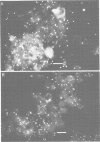Abstract
Limitations associated with immunofluorescence enumeration of bacteria in soil derive largely from the efficiency with which cells can be separated from soil particles and collected on membrane filters for staining. Many tropical soils fix added bacteria tightly, resulting in low recoveries. Eight soils, representative of three of the major soil orders found in the tropics (oxisols, vertisols, and inceptisols), were tested for recovery of added Rhizobium strains. All except one Hawaiian andept (Typic Eutrandept) yielded recoveries ranging from <1 to 13%. Recovery from the andept was 100%. In soil-sand mixtures, addition of only a small amount of soil caused a dramatic decrease in recovery of added rhizobia. Increasing the soil content of the mixture from 0% (10 g of sand) to 50% (5 g of soil-5 g of sand) reduced recoveries from >90 to <1%. Varying the ionic strength and pH of the extracting solution did not cause marked increases in recovery. Protein solutions, ethylenediaminetetraacetate, and NaHCO3, on the other hand, improved release of bacteria. We report a modification to the usual membrane filter immunofluorescence procedure which yielded consistently high and reproducible recovery (coefficient of variation, 30%) of rhizobia from several tropical soils. In the modified procedure, partially hydrolyzed gelatin, diluted in ammonium phosphate, was used to suspend the soil. This caused dispersion of the soil and release of the bacteria from soil flocs. The efficiency of recovery of Rhizobium spp. from several tropical and two temperate soils remained high as the content of these soils in soil-sand mixtures was increased from 0 to 100%. The modified membrane filter immunofluorescence procedure was used to follow the growth of a strain of chickpea (Cicer arietinum) Rhizobium in a sterilized oxisol. The results showed a close agreement with viable counts at different stages during the growth cycle. Diluent for the hydrolyzed gelatin also had a marked effect on recovery. The efficiency of release of Rhizobium spp. from an oxisol was in the following order for the diluents used: 0.1 M (NH4)2HPO4 > 0.1 M Na2HPO4 = 0.1 M sodium-phosphate-buffered saline (pH 7.2) > 0.2 M NH4Cl > 0.2 KCl > NaCl = LiCl > water.
Full text
PDF







Images in this article
Selected References
These references are in PubMed. This may not be the complete list of references from this article.
- Bohlool B. B., Schmidt E. L. Nonspecific staining: its control in immunofluorescence examination of soil. Science. 1968 Nov 29;162(3857):1012–1014. doi: 10.1126/science.162.3857.1012. [DOI] [PubMed] [Google Scholar]
- Hobbie J. E., Daley R. J., Jasper S. Use of nuclepore filters for counting bacteria by fluorescence microscopy. Appl Environ Microbiol. 1977 May;33(5):1225–1228. doi: 10.1128/aem.33.5.1225-1228.1977. [DOI] [PMC free article] [PubMed] [Google Scholar]
- Niepold F., Conrad R., Schlegel H. G. Evaluation of the efficiency of extraction for the quantitative estimation of hydrogen bacteria in soil. Antonie Van Leeuwenhoek. 1979;45(3):485–497. doi: 10.1007/BF00443286. [DOI] [PubMed] [Google Scholar]
- Reyes V. G., Schmidt E. L. Population Densities of Rhizobium japonicum Strain 123 Estimated Directly in Soil and Rhizospheres. Appl Environ Microbiol. 1979 May;37(5):854–858. doi: 10.1128/aem.37.5.854-858.1979. [DOI] [PMC free article] [PubMed] [Google Scholar]
- Schmidt E. L., Bakole R. O., Bohlool B. B. Fluorescent-antibody approach to study of rhizobia in soil. J Bacteriol. 1968 Jun;95(6):1987–1992. doi: 10.1128/jb.95.6.1987-1992.1968. [DOI] [PMC free article] [PubMed] [Google Scholar]
- Wollum A. G., Miller R. H. Density Centrifugation Method for Recovering Rhizobium spp. from Soil for Fluorescent-Antibody Studies. Appl Environ Microbiol. 1980 Feb;39(2):466–469. doi: 10.1128/aem.39.2.466-469.1980. [DOI] [PMC free article] [PubMed] [Google Scholar]




